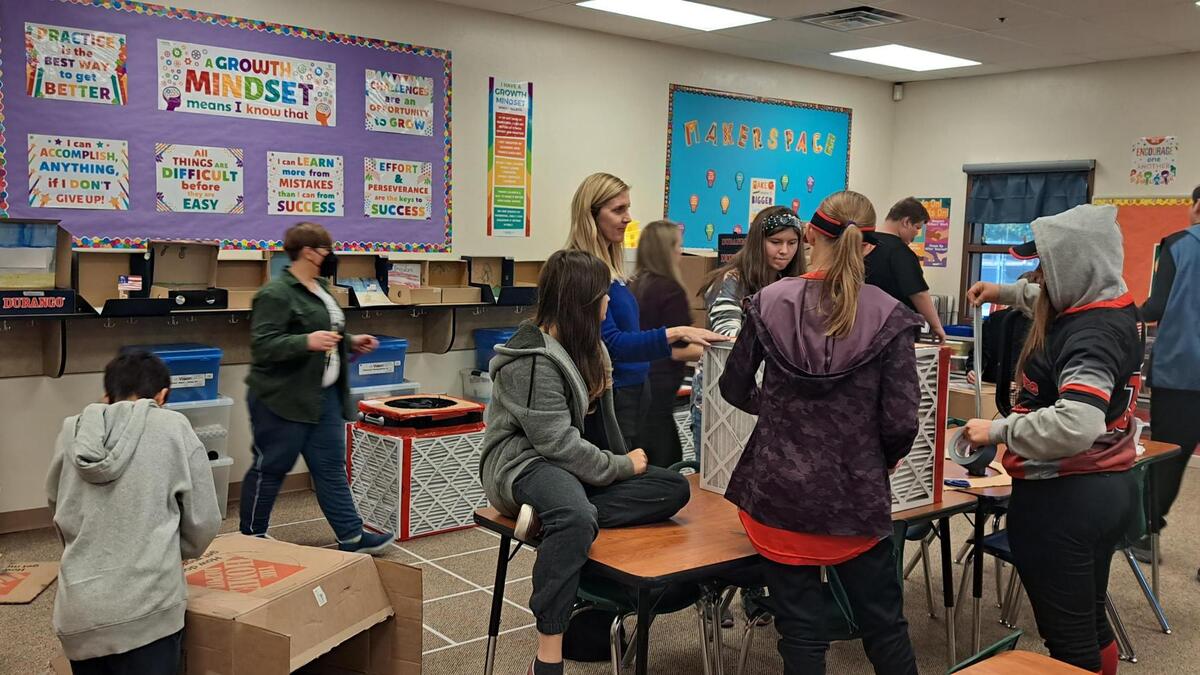New research: DIY air filters work better than commercial HEPA filters for fraction of cost

Megan Jehn (center, in blue), ASU professor and epidemiologist, helps Red Rock Elementary students bulid DIY air filters called Corsi-Rosenthal boxes. Photo courtesy Megan Jehn
We spend about 90% of our time indoors, breathing in air that can contain particulate matter like dust, wildfire smoke, volatile organic compounds, carbon dioxide and exhaled aerosols that may contain viruses and diseases. Studies also show poor indoor air quality can have negative effects on health and cognitive function.
Despite these statistics, there is a lack of federal regulations around indoor air quality (IAQ), and those regulations that do exist focus more on pollutants, not pathogens, according to newly compiled research by Megan Jehn, professor and epidemiologist at the School of Human Evolution and Social Change at Arizona State University.
“We need solutions to urgently address health inequities faced by communities that have been disproportionately impacted by infectious disease outbreaks and indoor air pollutants,” Jehn said.
To help fight the indoor air quality problem, Jehn has led the massive effort known as ASU’s Clean Indoor Air Project since the start of the COVID-19 pandemic to educate and help build and distribute do-it-yourself (DIY) air filtration systems across the country.
Recently, Jehn and colleagues published new research showing the DIY filters, known as Corsi-Rosenthal, or C-R, boxes, work better than commercial HEPA air cleaners for a fraction of the cost.
Related news
ASU is leading efforts to improve indoor air quality in several ways. Recently, the Center for Public Health Law and Policy at ASU’s Sandra Day O’Connor College of Law partnered with the Johns Hopkins Center for Health Security to build the Model State Indoor Air Quality Act (2023), a comprehensive legislative framework for helping to regulate indoor air quality.
The article, “Effectiveness of do-it-yourself air cleaners in reducing exposure to respiratory aerosols in US classrooms: A longitudinal study of public schools,” is published in the journal Building and Environment.
During their study, the team monitored DIY air units in primary and secondary public schools in Arizona and Connecticut during the 2022–23 school year.
“We monitored indoor air quality in 53 classrooms across five schools in two states over a six-month period,” Jehn and authors said in their article. “We observed a 43.3% reduction in PM2.5 concentrations and 30.6% reduction in PM10 concentrations in Arizona classrooms with the addition of a DIY air cleaner.”
Jehn’s team monitored indoor air quality at both rural and metropolitan schools in Arizona and Connecticut. The schools in Arizona used AC systems, and the schools in Connecticut had no AC but used window ventilation. Despite the different climate and locations, Jehn said one thing remained constant — schools' indoor air quality is universally poor, and a simple, low-cost intervention can have a huge impact.
“Simple, low-cost DIY air filtration units provide a cost-effective solution to efficiently reduce aerosol exposures in indoor classroom environments while schools pursue more sustainable building improvements necessary to meet health-based indoor air quality recommendations,” Jehn said.
New guidelines from the Centers for Disease Control and Prevention recommend five air changes per hour in school classrooms. Jehn explains this is defined as the number of times that the volume of air is turned over in a classroom, and most school classrooms don’t come close to reaching this threshold. C-R boxes can help.
More Health and medicine

Bird flu: Your questions on symptoms, spread and safety answered
Bird flu is no longer only “for the birds.”Infections have expanded beyond wild birds and poultry to a range of animals — from mice to mountain lions, dairy cows to domestic cats, and polar bears to…

Making medicine side-effect free
Many drugs that address medical conditions can come with serious side effects. In drug commercials, the litany of potential side effects is often longer than the benefits being touted. Carl…

Diagnostic research happening at ASU focused on detecting diseases earlier to save lives
It was one of America’s founding fathers, Benjamin Franklin, who may have foreshadowed today’s health care innovation when he quipped the adage: An ounce of prevention is worth a pound of cure.In…

